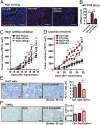Neuregulin 1-HER axis as a key mediator of hyperglycemic memory effects in breast cancer
- PMID: 23213231
- PMCID: PMC3529089
- DOI: 10.1073/pnas.1214400109
Neuregulin 1-HER axis as a key mediator of hyperglycemic memory effects in breast cancer
Abstract
Poor outcomes in diabetic patients are observed across a range of human tumors, suggesting that cancer cells develop unique characteristics under diabetic conditions. Cancer cells exposed to hyperglycemic insults acquire permanent aggressive traits of tumor growth, even after a return to euglycemic conditions. Comparative genome-wide mapping of hyperglycemia-specific open chromatin regions and concomitant mRNA expression profiling revealed that the neuregulin-1 gene, encoding an established endogenous ligand for the HER3 receptor, is activated through a putative distal enhancer. Our findings highlight the targeted inhibition of NRG1-HER3 pathways as a potential target for the treatment breast cancer patients with associated diabetes.
Conflict of interest statement
The authors declare no conflict of interest.
Figures





Similar articles
-
Neuregulin-1 induces cancer stem cell characteristics in breast cancer cell lines.Oncol Rep. 2014 Sep;32(3):1218-24. doi: 10.3892/or.2014.3330. Epub 2014 Jul 11. Oncol Rep. 2014. PMID: 25018110
-
HER3 is required for the maintenance of neuregulin-dependent and -independent attributes of malignant progression in prostate cancer cells.Int J Cancer. 2009 Dec 1;125(11):2565-75. doi: 10.1002/ijc.24651. Int J Cancer. 2009. PMID: 19530240
-
An antibody that locks HER3 in the inactive conformation inhibits tumor growth driven by HER2 or neuregulin.Cancer Res. 2013 Oct 1;73(19):6024-35. doi: 10.1158/0008-5472.CAN-13-1198. Epub 2013 Aug 8. Cancer Res. 2013. PMID: 23928993 Free PMC article.
-
The neuregulin-I/ErbB signaling system in development and disease.Adv Anat Embryol Cell Biol. 2007;190:1-65. Adv Anat Embryol Cell Biol. 2007. PMID: 17432114 Review.
-
Hyperglycemic memory in metabolism and cancer.Horm Mol Biol Clin Investig. 2016 May 1;26(2):77-85. doi: 10.1515/hmbci-2016-0022. Horm Mol Biol Clin Investig. 2016. PMID: 27227713 Review.
Cited by
-
LncRNA Expression Profiles in C6 Ceramide Treatment Reveal lnc_025370 as a Promoter in Canine Mammary Carcinoma CHMp Cells Progression.Curr Issues Mol Biol. 2024 Dec 16;46(12):14190-14203. doi: 10.3390/cimb46120849. Curr Issues Mol Biol. 2024. PMID: 39727977 Free PMC article.
-
Converging Relationships of Obesity and Hyperuricemia with Special Reference to Metabolic Disorders and Plausible Therapeutic Implications.Diabetes Metab Syndr Obes. 2020 Mar 30;13:943-962. doi: 10.2147/DMSO.S232377. eCollection 2020. Diabetes Metab Syndr Obes. 2020. PMID: 32280253 Free PMC article. Review.
-
Hyperglycemia as a risk factor for cancer progression.Diabetes Metab J. 2014 Oct;38(5):330-6. doi: 10.4093/dmj.2014.38.5.330. Diabetes Metab J. 2014. PMID: 25349819 Free PMC article. Review.
-
Hyperglycemia Promotes Liver Metastasis of Colorectal Cancer via Upregulation of Integrin αvβ6.Med Sci Monit. 2021 Aug 19;27:e930921. doi: 10.12659/MSM.930921. Med Sci Monit. 2021. PMID: 34408123 Free PMC article.
-
Metabolic memory: mechanisms and diseases.Signal Transduct Target Ther. 2024 Feb 28;9(1):38. doi: 10.1038/s41392-024-01755-x. Signal Transduct Target Ther. 2024. PMID: 38413567 Free PMC article. Review.
References
-
- Vigneri P, Frasca F, Sciacca L, Pandini G, Vigneri R. Diabetes and cancer. Endocr Relat Cancer. 2009;16(4):1103–1123. - PubMed
-
- Stattin P, et al. Prospective study of hyperglycemia and cancer risk. Diabetes Care. 2007;30(3):561–567. - PubMed
-
- Jee SH, et al. Fasting serum glucose level and cancer risk in Korean men and women. JAMA. 2005;293(2):194–202. - PubMed
Publication types
MeSH terms
Substances
Associated data
- Actions
- Actions
Grants and funding
LinkOut - more resources
Full Text Sources
Medical
Molecular Biology Databases
Research Materials

